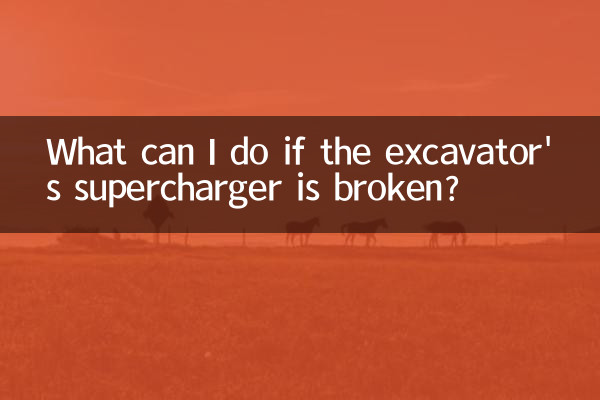What are the consequences if the excavator supercharger is broken? Comprehensive analysis of fault causes and solutions
Recently, a hot topic in the field of construction machinery has focused on the failure of excavator superchargers. As one of the core components of the excavator engine, once the supercharger is damaged, it will directly affect the working efficiency of the equipment. This article will use structured data analysis to explain in detail the common manifestations, causes and countermeasures of excavator booster failures.
1. Summary of recent hot topics in construction machinery (last 10 days)

| Ranking | hot topics | attention index |
|---|---|---|
| 1 | Common faults of excavator booster | ★★★★★ |
| 2 | Impact of the Implementation of National IV Emission Standards | ★★★★☆ |
| 3 | Development of new energy engineering machinery | ★★★☆☆ |
| 4 | Hydraulic system maintenance tips | ★★★☆☆ |
2. Typical symptoms of excavator booster failure
| Symptoms | Possible reasons | Failure level |
|---|---|---|
| Engine power reduced | Insufficient boost pressure | serious |
| Blue smoke coming from the exhaust pipe | Damaged turbine end oil seal | urgent |
| Abnormal noise | Bearing wear or blade deformation | medium |
| Abnormal oil consumption | Seal failure | serious |
3. Analysis of the main causes of supercharger damage
1.Lubrication system problems: According to statistics, about 45% of supercharger failures are caused by insufficient oil supply or substandard oil quality. Long-term use of inferior engine oil will lead to poor lubrication and accelerated bearing wear.
2.Foreign matter enters: When the air filter fails, dust and particles enter the inside of the supercharger, causing damage to the impeller. This is one of the most common problems in a construction site environment.
3.Improper operation: High-load operation immediately after cold start, or not idling before shutting down, will cause thermal shock to damage the supercharger components.
4.natural aging: Generally, the design life of a supercharger is 8,000-10,000 working hours. After the time limit is exceeded, the performance of each component will decrease significantly.
4. Comparison of fault response plans
| solution | cost estimate | Expected results | Applicable situations |
|---|---|---|---|
| Whole replacement | 8000-15000 yuan | Best | Severely damaged or elderly equipment |
| Professional maintenance | 3000-6000 yuan | good | moderate damage |
| Temporary processing | Within 1,000 yuan | limited | Minor malfunction emergency |
5. Preventive maintenance suggestions
1.Change engine oil and filter regularly: Strictly follow the maintenance cycle specified by the manufacturer. The replacement interval should be shortened under severe working conditions.
2.Correct operating habits: Idle for 1-2 minutes after starting, and idle cooling is also required before shutting down.
3.daily inspection: Pay attention to the color of the exhaust smoke, listen for abnormal sounds, and investigate in time if any abnormalities are found.
4.Professional testing: Special equipment should be used to check whether the boost pressure is normal every 2000 working hours.
6. Analysis of current situation of maintenance market
According to the latest industry data, the excavator supercharger repair market shows the following characteristics: original factory parts are generally more expensive but of reliable quality, sub-factory parts have obvious price advantages but have quality risks, and the technical level of professional repair shops is uneven. It is recommended that users choose an appropriate maintenance solution based on the value of the equipment and usage requirements.
In summary, the fault of the excavator booster cannot be ignored, and timely diagnosis and treatment can avoid greater losses. Through standardized maintenance and correct operation methods, the service life of the supercharger can be effectively extended and the stable operation of the equipment can be ensured.

check the details

check the details